 |
|
|
Popular topics on this page:
Beckman Circuitmate DM25L schematic
Heath Malmstadt/Enke Instrumentation Laboratory
Free circuit simulation software
Carlingswitch VJD1 illuminated rocker switch
What's a DEPAR BUEPDRAVE PRG USB device?
No, the comet is NOT going to hit us
Remove from server when deleted from 'Deleted Items'
Oxford English Dictionary hangs when you click "Search"
When Windows Installer goes wild
DirectShow and .NET
Astrophotos:
3C273
Comet 73P Comet 73P Comet 73P
Cosmic rays
Jupiter
M3 M51 M104
Stargate
Scroll down or press Ctrl-F to find other topics, or check previous months.
BOOK SALE - I'm selling off some scholarly books via Amazon Marketplace. Have a look!

|
2006
May
30-31
|
You are not a Homo sapien, and you don't have a bicep
I am mildly annoyed at the makers of the robot
"Robosapien"
for perpetuating a common Latin spelling error.
The species name for human beings is Homo sapiens
("intelligent human being") and is not plural.
If you wanted to apply the name to more than one of them,
they'd be Homines sapientes, "intelligent human beings."
Some Latin words end in -s; deal with it.
A discus is not more than one discu.
A virus is not more than one viru.
So why should a biceps be more than one bicep...
or a Homo sapiens be more than one Homo sapien?
(And does anybody think a moose is more than one moo?)
In Latin, sapien is not a word.
And the Latin plural of biceps
is bicipites, although it's OK with me if you say "bicepses"
when you want to denote more than one of them in English.
That's all until June. In the meantime, look up the correct
plurals of octopus and virus. You'll be surprised!
Permanent link to this entry

|
 |
2006
May
28-29
|
When Windows Installer goes wild
Windows Installer pops up when you open almost any window
Windows Installer can neither install nor uninstall a program
Windows Installer complains that the patch file is corrupted or unreadable
Last night (May 28) I made two computers into one.
To be precise, I moved the boot disk of Melody's old computer (with all her files and software)
and made it the boot disk of our cheap but good eMachines desktop that is a few years younger.
I followed the procedure
here, and for the most part it worked.
But a couple of Adobe products were corrupted (no longer runnable), and Windows Installer would pop
up with "Preparing to install..." (and then, after about a minute, log a failure event)
almost every time I opened any window. My Computer and Internet Explorer were particularly afflicted.
It turns out that these were two faces of the same problem.
Adobe Acrobat hooks itself to almost every window that can print,
and when it's corrupted, it tries to fix itself at every inopportune moment.
But I couldn't uninstall or reinstall Acrobat. The installer (Add/Remove Programs)
complained that the patch file was corrupt.
Fortunately, Microsoft has had the same problem (with installations of Office) and has worked out a solution.
The problem arises when the Registry contains incorrect or incomplete information about how the
software is installed. This is in some deeply hidden Registry keys pertaining to the Installer, not
anything obviously pertaining to the software.
Microsoft has published a
Windows Installer cleanup utility for dealing with
such situations.
It doesn't uninstall software, nor does it remove anything from your disk or registry except
the records of how to install it.
To fix the problem, you must therefore run the cleanup utility, then reinstall the exact same software
in the same place, and finally uninstall it (if you want it uninstalled).
At least when they make a mess, they have to find a way to clean it up!
Permanent link to this entry

|
 |
2006
May
27
|
DirectShow meets .NET and C#
Microsoft Windows has two rival video systems.
The old one, Video for Windows, is basically an extension of the Windows procedure-call API
and is simple to use, but brittle – it breaks on lots of newer video file
formats. In particular, it doesn't support .WMV, nor DV AVI.
But it is still widely used for scientific work, and I've enjoyed
Corinna John's
C# wrappers for it.
The new (well, 10-year-old), powerful video system is called DirectShow.
It's written in COM,
and programming with it is a very strange experience.
Like old IBM mainframe JCL,
COM gives me the topsy-turvy feeling that
the hard things are all easy and the easy things are all hard.
Brilliant software insights are mixed with illegible and clumsy notations.
I understand the power of COM but don't
enjoy working with it at all. Apparently, neither do a lot of other people, and that's why
we now have .NET Framework.
Well... Some very generous and right-thinking programmers on SourceForge have created and shared
a powerful set of open-source
C# wrappers for DirectShow, with a fine set of sample programs.
You can get them here, free
of charge. They're under the LGPL,
which, if I understand it right,
means that the DLLs are freeware but can be
used in commercial products. And they are genuinely easy to use.
Permanent link to this entry

|
 |
2006
May
26
|
Who remembers Malmstadt/Enke?
If you studied electronics in college in the late 1960s
(or played around in a college lab, as I did), you may well
have encountered the amazing, bluish-green
Heath Malmstadt/Enke Instrumentation Laboratory system.
This was a set of coordinated test equipment and breadboards
that provided a practical way of breadboarding circuits
without soldering in the vacuum-tube era, an impressive
achievement.
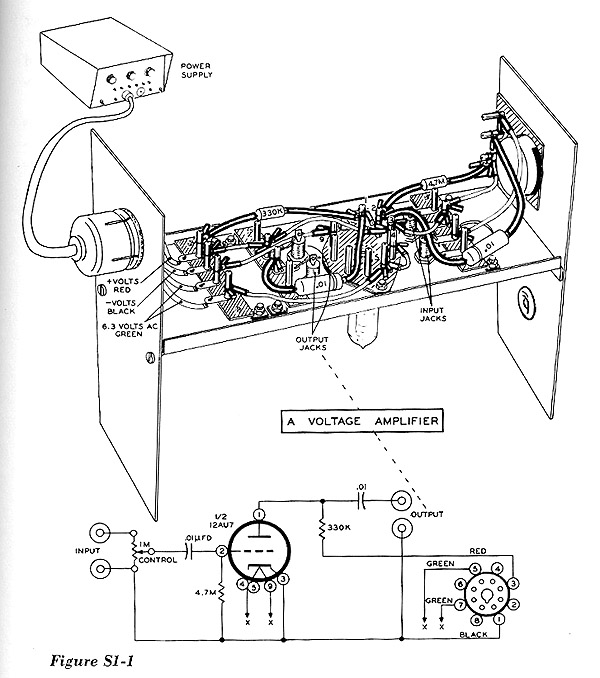
Occasionally, Malmstadt/Enke instruments turn up on eBay; the breadboards are
probably the rarest item in the set. Search for Heath products with model
numbers that begin with EU and EUW.
The test equipment was notable in its own time for being much less expensive
than competitors.
Like most Heath test equipment, it was cheaply made, but not too cheaply;
the price-performance ratio was exceptionally good.
The breadboard had no competition as far as I can determine.
Multiple breadboards could be bolted together to build complex circuits.
I do not presently own any of this equipment, although I admired it in catalogues
and occasionally got to use it as a high school student
at Valdosta State College in the late 1960s.
I've collected some information
in this PDF file.
Rather full documentation is in the book
Electronics for Scientists,
by Malmstadt, Enke, and Toren,
which can often be found
secondhand on Amazon
and is worth reading for its own sake.
Permanent link to this entry

|
 |
2006
May
25
|
Quote for the day
"The only alternative to tradition is bad tradition." –
Jaroslav Pelikan.
Permanent link to this entry

|
 |
2006
May
24
|
Jupiter, Callisto, Io, and Europa

Here's last night's catch. We had unusually steady air. The other thing that was unusual
is that the earth and Jupiter are positioned in their orbits in such a way that we can see
satellites pass north or south of the planet; usually they pass in front of it or behind it
as they orbit from west to east.
8-inch Meade LX200 telescope, prime focus, Philips ToUCam, 2000 frames of video recorded
and about the best 1000 stacked and enhanced.
Permanent link to this entry
Some interesting reading
Interesting things I've found on line recently...
The London Stone is an
ancient pre-Roman artifact, mentioned by Shakespeare, and now housed in a sporting-goods store.
Deep thinking: St. Bonaventure's
Journey
of the Mind (Itinerarium). I haven't read it yet.
The Purdue University
Horticultural
Humor Page.
An easy-to-build
tiny FM transmitter
for electronics beginners.
The construction technique, with unetched printed circuit board used as a ground plane,
is a time-honored one that I've never tried. I may build one, just to see how well it works.
Permanent link to this entry

|
 |
2006
May
22-23
|
Red, white, and blue clouds

This isn't a distant nebula. It's a cloud formation I saw outside just a few minutes ago.
I grabbed my Canon Digital Rebel, took the picture, brought it onto the laptop,
and enhanced the color and contrast with Photoshop. Voilà!
Permanent link to this entry

|
 |
2006
May
21
|
Miscellany
 What are those things on Inuyasha's face in the picture?
Apparently, they are a Japanese representation of veins throbbing on an
anguished person's forehead.
They remind us that many of the things we see in drawings – arrows,
starbursts, etc. – are not pictures at all; they're
arbitrary symbols that we've gotten used to.
What are those things on Inuyasha's face in the picture?
Apparently, they are a Japanese representation of veins throbbing on an
anguished person's forehead.
They remind us that many of the things we see in drawings – arrows,
starbursts, etc. – are not pictures at all; they're
arbitrary symbols that we've gotten used to.
(They are not the logo of the
Atlanta airport,
much as they look like it!)
Speaking of drawings, I'm beginning to suspect that
Google Sketchup
may have finally figured out a good user interface for 3-dimensional drafting.
Maybe Sketchup is doing for 3D what Visio did for diagrams.
Try it and see; it's free for noncommercial use.
Today I made minor revisions to my existing blog entries
about
fixing a Lexmark Optra R printer
and about
The Gospel of Judas
(readers will be relieved to know the two are unrelated).
Sunday, December 12, 1965, was a memorable day.
At least, one event was memorable.
My father and I were watching the launch of
Gemini 6.
The rocket ignited right on time,
smoke billowed out
from under it, and
then it didn't move.
After a while the astronauts came out and the launch was rescheduled for December 15.
At the time, we had no idea what a fright this was for the astronauts.
If the rocket had lifted off even an inch, it would have exploded coming
back down, and the astronauts would have had to use their ejection seats,
which were unproven and thought to be very dangerous.
Fortunately, Commander Schirra made the correct decision not to eject; he
hadn't felt even an inch of movement.
Wikipedia's articles on the U.S. space program are very informative and worth reading.
Two creative ways to get yourself in trouble:
- (1) Fall off a cruise ship.
It's surprisingly common for people to go overboard and drown, and
this CNN story
sheds some light on why:
Missing-person reports on ships are very common, and nearly all of them are mistaken.
You'd think it would be a simple matter to monitor the sides of the ship with security cameras
and detect it the moment someone goes over. Why not?
- (2) Dial random numbers on the telephone in search of adventure.
This was done by a
12-year-old girl near Boston who got herself
kidnapped.
And apparently, it's a fairly common practice.
Maybe this explains some of the wrong numbers I get.
I make a point of answering the phone "This is Michael Covington, may I help you?"
rather than "Hello," and a lot of people don't catch a word of it!
Permanent link to this entry

|
 |
2006
May
20
|
Free circuit simulation software
The other day I wrote about
Multisim circuit simulation software,
which is available as a 45-day free trial, but otherwise quite
expensive (on the order of $2000).
Is there anything like this that is free of charge, at least in
limited form, and doesn't expire after 45 days?
Yes; so far, I've found three.
One is the demo version of
OrCAD,
which is limited only as to the size of the circuit.
It's a huge download (over 200 MB) and comes with copious
documentation.
I haven't gotten started with OrCAD yet. It's apparently very powerful but is an order
of magnitude harder to get started with than Multisim.
(See these handy notes
about an earlier version, and note that what you normally want is a
transient analysis, i.e., a virtual oscilloscope.)
Since OrCAD is widely used by professionals, the effort of learning it is likely to be worthwhile.
I had some trouble getting OrCAD Demo.
OrCAD's web site is supposed to send you e-mail once you register for the
download. After three tries, I concluded those e-mails just weren't being sent.
I e-mailed OrCAD's webmaster, as directed on the web page, and got an autoreply
from a software support company that didn't identify itself as OrCAD.
Finally I contacted OrCAD's North American sales representative
and got immediate help.
The parts library for OrCAD's free demo is rather restricted.
Also, curiously, OrCAD doesn't seem to know about My Documents.
You have to navigate to your My Documents folder by finding it
under C:\Documents and Settings.
The second is
Micro-Cap, whose demo version is designed for
students and is relatively easy to get started with
(though not as easy as Multisim).
In the free demo version, the parts library is limited but consists
mostly of commonly used items, with no strong preference as to manufacturer.
Of the three, this one is the most like Multisim.
The third is LTSPICE, also known as SwitcherCAD.
This is what you see below.
It's small, quick, and easy to get started with once you realize that the power supply
is hidden under Components, Misc, Voltage.
LTSPICE was created by Linear Technology Corporation to promote their ICs, many of which are
used in switching power supplies (hence the name SwitcherCAD).
Switching power supplies involve oscillators, inductance, and calculations you can't do
in your head, hence the need for the software.
LTSPICE also includes many parts made by other companies – but only
when Linear doesn't have a competing product.
All the op-amps, for instance, are from Linear and have LT numbers.
Compared to Multisim, LTSPICE has a less copious selection of parts available
and has more involvement with traditional SPICE (e.g., you see, and can edit, the
traditional .tran command that starts each simulation).
Some of the parts in the library are just symbols to use with a SPICE model of
your own devising. My favorite chip, the 555 timer, is present only as an "idealized"
model (whereas Multisim gives you realistic bipolar and CMOS versions).
There were two "gotchas" with LTSPICE. When installed, it puts its shortcuts only into the
start menu of the person who installed it.
To put it onto a computer for general use, install as Administrator and then
move the shortcuts from Administrator\Start Menu to All Users\Start Menu,
then add "Users" to the list of those authorized to read and execute it.
Second, by default it wants to save your files in C:\Program Files, where you
probably don't have permission to write.
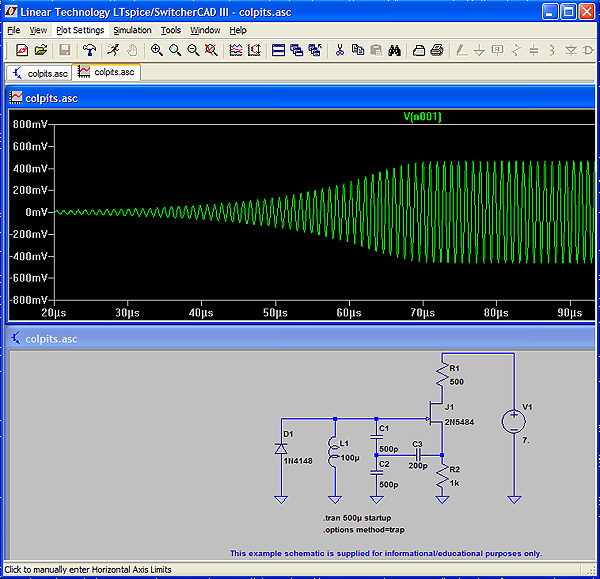
Permanent link to this entry

|
 |
2006
May
19
|
Seven easy pieces
What's remarkable about the following seven astrophotos is
how little work they were.
I put my Canon Digital Rebel on the back of my 8-inch f/10 telescope
using a Celestron compressor lens to get effective f/5.6.
The telescope, a Meade LX200, has a "smart drive" with permanent
periodic error correction, so it tracks very smoothly, and its
permanent pier is polar-aligned to within about 0.1 degree.
I focused the camera with the Canon Angle Finder and did not use an
autoguider; no guiding corrections were made during the exposures.
Each exposure was 3 minutes; most of the pictures are stacks of
three of these.
Dark frame subtraction, alignment, and stacking were done
with Images Plus; final processing, with Photoshop
(usually involving some unsharp masking).
[Note added May 20:
Add Images Plus to the list of software that won't run unless
you're logged on as Administrator.
Even altering the file permissions won't fix this.]
First, the "Stargate asterism," so named because it resembles
a logo formerly used by the TV show Stargate SG-1.
This is a small group of stars in Virgo
(not actually a cluster; they're different distances from us)
in almost the same
direction as M104. Here you see a single 3-minute exposure.

Next, the galaxy M104 itself, a stack of three 3-minute exposures:

The quasar 3C273, same technique, showing stars down to 16th magnitude.
This quasar is probably the most distant object I've photographed.
It's one of the brighter stars near the middle; the arrow indicates it.

The spiral galaxy M51, same technique again:
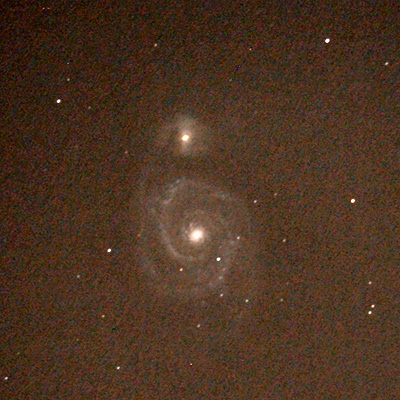
Coming back into our own galaxy, the globular cluster M3,
a composite of two 3-minute exposures:

And finally, very close to home (but still much farther than the Moon),
some fragments of Comet 73P/Schwassmann-Wachmann. Here's Fragment C:
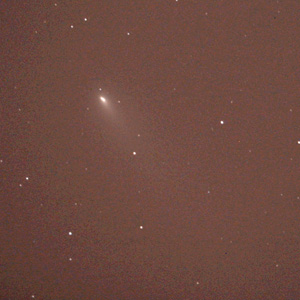
And here's Fragment B along with another fainter fragment (arrow).

Each of these comet pictures is a single 3-minute exposure.
Even in so short a time, the image of
each piece of the comet is elongated
by the comet's orbital motion.
Permanent link to this entry

|
 |
2006
May
18
|
It was against the law...
It turns out laws were violated when
our local jeweler
autodialed everybody in town and played recordings
into their telephones.
The Do-Not-Call List deals with telemarketing by human beings.
Use of autodialers to deliver ads to residences is
illegal even if they're not on the Do-Not-Call List
( 47 USC 227 (b)(1)(B)).
Autodialing the University probably wasn't illegal, but it wasn't wise either.
Permanent link to this entry
Oxford English Dictionary hangs when you click "Search"
 The Oxford English Dictionary on CD-ROM is a very handy piece of software; you can
copy all the data files to your PC and run it without the discs.
The Oxford English Dictionary on CD-ROM is a very handy piece of software; you can
copy all the data files to your PC and run it without the discs.
I've been having problems with it starting up slowly, or hanging altogether,
when I click "Search" to open up the dictionary.
The cure is to tell F-Secure Antivirus not to search the OED's DATA folder.
You can exclude specific folders from automatic virus searching
(even if you're not Administrator), and this greatly
speeds up programs that have to open large data files.
Since the F-Secure data files have the .htm extension, they get searched
as if they were web pages.
Permanent link to this entry

|
 |
2006
May
17
|
Yes, it's that bad
The Da Vinci Code opens to very negative reviews
Besides annoying all the Christians in the world with its distortions of
history and misrepresentations of real people and organizations,
The Da Vinci Code is, to my surprise and delight, getting
catcalls, not applause
at the Cannes Film Festival.
The plain fact seems to be that a puzzle does
not make a very good movie, and even if it did, this one isn't
very well made.
Much of the furor over The Da Vinci Code comes from the fact that
the author didn't draw the line between fact and fiction
in any sensible place.
He was taken in by a hoax (the Priory of Sion) while researching the "real history"
that he claims is behind the book.
He uses a real organization (Opus Dei) and makes it into a murderous cult.
He also uses a living person (art historian Maurizio Seracini) as a character without his permission.
In short, it's
neither fact nor fiction – it's confusion.
Fiction about an alternate world can be enjoyable.
What if the South won the Civil War?
Or the Americans
lost the War for Independence?
But The Da Vinci Code isn't that.
It's apparently designed to confuse and spread misconceptions.
What would happen if someone did the same thing to the
history of the American Revolution or World War II?
Permanent link to this entry
An interesting bylaw
Speaking of things Roman...
I've just learned that the Catholic Church has a bylaw for the electing of Popes that solves
a potential problem in an interesting way. Managers and politicians, take note.
The bylaw says that if any of the Cardinals is under excommunication or censure,
that excommunication or censure is set aside for the purpose of electing or being
elected Pope. (Details
here.)
The effect?
No papal election can be set aside by proving, later, that one or more of the Cardinals
was under excommunication or censure at the time.
It is possible to incur excommunication automatically, without a court passing sentence,
by doing certain things, such as joining certain anti-Catholic organizations.
Thus, a Cardinal could be under excommunication without anyone knowing it at the time.
Allegations could be brought later.
If a papal election were invalidated ex post facto, all sorts of things would go wrong.
The cardinals appointed by the invalidated Pope would be invalidated.
Thus, so would any further papal elections they had carried out.
In fact, there are
people now who contend
that the election of John XXIII was invalid;
thus the cardinals that he appointed are invalid;
thus Paul VI, John Paul I, John Paul II, and Benedict XVI are not validly elected
because there was a steadily increasing number of invalidly
appointed cardinals among the electors; and so on.
Computer scientists will recognize the cascading power of recursion here.
That's what this unusual bylaw is designed to fix. I wonder if similar rules would be
useful in other types of organizations.
Permanent link to this entry
Simulating circuits with Multisim
I'm trying out the latest version of Electronics Workbench,
which comprises Multisim circuit simulation software as well as
other tools which will even lay out the printed circuit board for
whatever you've designed.
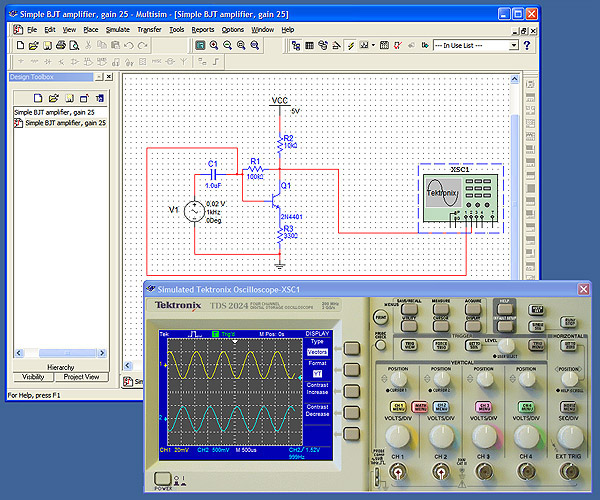
The latest version has a free 45-day trial.
You can download it
here.
Definitely an interesting thing to try out! I like it particularly for designing
tricky analog circuits such as active filters.
The realistically simulated Tektronix and Agilent oscilloscopes are especially fun.
This software may actually teach our students how to use our test equipment.
[Note added May 20: Like much engineering software, Multisim currently violates
standard Windows programming procedures
in at least one way – it expects you to log in as Administrator.
To enable ordinary users to run it, give them full control of its folder
within Program Files, or perhaps specific files or subfolders within it.]
Permanent link to this entry

|
 |
2006
May
16
|
How not to advertise a jewelry store
This morning, everybody in my office got a phone call or voicemail from
a prominent local jeweler
advertising a free ring-cleaning offer.
The receptionist got multiple copies of the voicemail from all the
telephones that roll over to hers.
I called the store to find out what was going on.
They were autodialing, and playing a recording to,
"random" phone numbers that were checked against the Do-Not-Call List.
Of course, our phones, being state government, are not on the list.
Frankly, until today it didn't occur to us that they needed to be.
Why is it a bad idea to autodial telephones without knowing whose
they are? If you can't think of any reasons, let me suggest a few...
(1) Even if you're not violating it, remember why there's a Do-Not-Call List.
People don't like to receive recorded commercials by telephone.
It may be technically legal in some circumstances, but it doesn't win customers.
I wonder if the store owner's home telephone is on the Do-Not-Call List.
Probably so. "Do unto others..."!
(2) This ad campaign looked, at first sight, like a deliberate attempt to
disrupt the University's voicemail system by filling up its memory with a vast
number of copies of the same message. That would be a type of denial-of-service attack.
Our security people are still looking into that possibility.
(3) The University has telephones in conference rooms and other places where
incoming calls will disturb people.
Their numbers are unlisted, but if you dial "random" numbers, you'll hit them,
possibly interrupting a meeting or a class.
(4) What about police departments, fire departments, and hospitals? In particular,
if you're calling all the unlisted numbers in town, you'll ring every bedside
telephone in the whole hospital, waking up every patient. That is not
a nice thing to do! (And autodialing health-care facilities is illegal.)
In short: This particular jewelry store has not endeared itself to the University.
I presume some unscrupulous ad agency sold them a bill of goods – assured
them that this scheme would make money, that it was legal, and that nobody
would mind. Falsch!
Permanent link to this entry
Multimeter madness
I have yet another multimeter, a
B&K 2706A,
picked up on eBay because it was too cheap not to.
(About $32 delivered, as I recall.)
It's like the 2704A with a temperature scale added;
its sensor is a standard Type K thermocouple.
And in response to popular demand, I've put the
schematic of the Beckman Circuitmate DM25L
on line
even though my own DM25L is beyond repair.
Permanent link to this entry

|
 |
2006
May
14-15
|
Two ecclesiastical notes
Jaroslav Pelikan,
the great church historian who converted from Lutheran to Eastern Orthodox
at an advanced age, and who was Dean of the Yale Graduate School
when I was a student there,
has died at age 81.
He will be missed. I have
his five-volume magnum opus
on my shelf and refer to it
regularly. His big message to his fellow Protestants was that you cannot jump straight from the Bible
to the modern era without considering the development of Christianity during the intervening centuries.
Sample some of Dr. Pelikan's erudite writing
here.
Meanwhile, Christian financier
Gary Moore
sounds two warnings about the
"Christian Money Management"
movement (of which I have also been somewhat critical):
(1) It does not make sense to demand that people always
be "debt-free" since we have everything on loan from God
in the first place.
The compulsion to be "debt-free" can stem from a kind of selfishness that is contrary to Christian values,
the desire to be "independent" even of the Creator.
It is also a needless burden on people who could prosper by borrowing money or other resources.
Borrowing, says Moore, is Biblical; Jesus even rode into Jerusalem on a borrowed donkey.
(2) A Christian cannot be a perfect laissez-faire capitalist. The free market is good for a lot of
things, but it's no substitute for good sense. The free market does not authorize you to ignore
the known effects of your actions.
Permanent link to this entry

|
 |
2006
May
13
|
Con game of the day: Fake checks
The other day somebody sent to Covington Innovations a check for $3.25,
with the "memo" field filled in as "Computer Software" and a fake purchase
order number.
I do make software, and $3.25 would pay for about 90 seconds of
my consulting time.
On the back of the check, in very fine print, was a statement that by
endorsing this check I am signing up to pay $27.50 per month to be
listed in YP.COM.
(Note: I have no proof that the management of YP.COM was behind this.
It may have been done for/to them by an ad agency or even an impostor.
Just like spam, deceptive advertising should not be assumed to come
from where it claims to come from.)
In my opinion, it ought to be illegal to put a contract into the
endorsement of a check (other than maybe an agreement that the check is
payment for a specific debt).
But even if it's technically legal, this check went over the line
by including the false purchase order information under "memo."
The sender clearly hoped that someone at Covington Innovations would
deposit it without reading the fine print on the back.
It was drawn on a tiny state-chartered bank in Minnesota.
I sent it to the Federal Reserve System, from which it will filter down
to the Federal Reserve Bank of Minneapolis and then the appropriate regulators.
From the Fed's point of view, of course, the issue is the bank's complicity
in an apparently deceptive practice.
I suspect they ended up with a tiny bank, far from home, because the
big banks wouldn't play the game.
It's even imaginable that the whole bank is fake.
Such things have happened!
My other reason for contacting the Fed was of course to suggest a
new regulation.
I cannot think of any legitimate reason to put subscription
contracts or the like into the endorsements of checks.
Deception seems to be their main purpose.
Why not make life easier for everybody by banning them?
Permanent link to this entry

|
 |
2006
May
11-12
|
My best pen yet?

This hasty snapshot doesn't do justice to the fountain pen that Melody's father,
Jim Mauldin, made as a surprise present for me a few days ago.
Its barrel and cap are not metal but turned ebony wood.
The cap screws onto either end of the barrel, and when the pen is capped,
it's sealed with an O-ring. Clearly, the maker of this pen is a machinist at heart.
The nib is European, has an iridium point, and takes international cartridges.
To write well, it needed to be opened up just a bit by inserting a razor blade
about 1/16 of an inch between the tines.
In my experience, most pens need this.
When the nibs leave the factory,
they are deliberately left very tight so that they can be used
by people who bear down as hard as if they were using a ballpoint.
You, too, can get a pen custom-made. Call Jim Mauldin at 770-867-5944
or e-mail me and I'll pass the request along.
He gets requests regularly from my web site.
Permanent link to this entry
Amazing comet photo (not mine)
Have a look at
this
amazing picture of part of Comet 73P/Schwassmann-Wachmann passing almost in
front of the Ring Nebula.
The brightest fragments (B and C) are now in Cygnus and have brightened to
sixth magnitude.
We've had cloudy weather, and I've only had one quick look at them lately.
That was last night.
At 1:30 a.m., Babbage, whom Melody has dubbed "the astro-dog," came and woke me up,
demanding to go outside.
I grabbed my binoculars and got a good look at Fragment B while Babbage ate clover
or something.
Within fifteen minutes, the sky was cloudy; he somehow knew just when to get
me up, in the short interval between the comet's rising and the arrival of the clouds.
Some astrophotos of mine from more than a week ago are going to appear here soon,
including an image of the comet through the telescope.
Permanent link to this entry

|
 |
2006
May
10
|
A treasury of semiconductor and IC data sheets
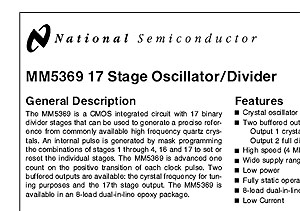 DatasheetArchive.com has
greatly expanded its coverage.
DatasheetArchive.com has
greatly expanded its coverage.
That's a free archive of data sheets on semiconductors and ICs past and present.
They make their money by trying to link you to distributors who still have obsolete parts
available.
In the 1980s, everybody had a bookshelf of IC data sheets.
(I still do; I got a good bit of my technical education from the National Semiconductor
"Linear" volume.)
Then, around 2000, most people threw them away.
From now on, data will be on the Internet. Right?
Partly right. The moment a part is discontinued, its data sheet disappears from the
manufacturer's web site, even though the parts continue to be available, in small
quantities, for 20 years or more.
There's now a wave of discontinuations going on.
Use of lead solder in consumer electronics is now prohibited in Europe.
So all the slow-selling ICs that have lead in them are going to be discontinued
and not replaced with lead-free versions.
This is a boon for experimenters like me, in America, who will be able to buy
the lead-coated parts cheaply – if we can still get data sheets to
tell us how to use them.
And of course if you're fixing an older piece of equipment, you need data on what's in it.
That's why DatasheetArchive is indispensable.
Permanent link to this entry

|
 |
2006
May
9
|
Oops, we forgot to put the help files on the CD!
Today's dubious achievement award goes to
Adobe Illustrator CS2
for arriving incomplete.
To use it properly, you have to download 30 megabytes of things from Adobe:
the help files (a ZIP file that you put in the appropriate
place under Adobe Help Center
in Program Files), the update from 12.0.0 to 12.0.1,
and the Security Patcher, which updates Help Center and does a few other
small things.
So Adobe gets low marks for the way the software is delivered.
Illustrator itself, however, strikes me as an excellent product.
I bought it today to end a frustrating 15-year relationship with Corel Draw,
which seems to have declined in quality over the years.
What really bothers me about Corel is that it keeps getting more
complicated, and they keep rearranging the menus so you have to learn
a new set every time there's an update.
Illustrator is simple and well organized though powerful.
I figure it will take me about half an hour to learn to use it productively.
Of course, I use Visio for technical diagrams; Illustrator (or Corel)
is for things that don't fit the Visio model very well.
Permanent link to this entry

|
 |
2006
May
8
|
Prophetic words...
|
The last sentence of yesterday's entry was predictive...
The old Beckman DM25L, may it rest in peace, suffered some kind
of catastrophic failure while I was cleaning its contacts yesterday
and is now a random-number generator.
So there is a
B&K 2704B, its nearest living relative,
on the way to me now from
Digi-Key.
The two meters complement each other.
The 2704B measures current
and transistor gain, both of which the Fluke 110 lacks,
and measures capacitance over a wider range.
The transistor-gain feature isn't for testing transistors
so much as for identifying them and figuring out
which pin is which.
I'll probably take another stab at fixing the Beckman.
I have a schematic diagram, and all the parts are replaceable.
Of course, a schematic diagram that revolves around a 50-position (?),
8- or 10-pole switch is not a simple thing!
|
|
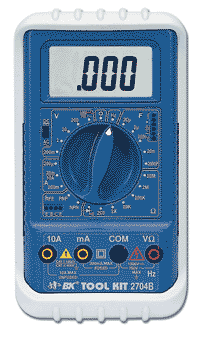 |
Permanent link to this entry

|
 |
2006
May
7
|
Remove from server when deleted from 'Deleted Items'
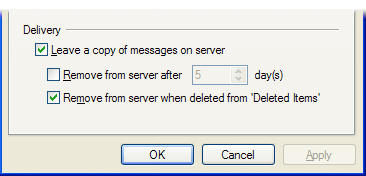 I use Outlook Express to check e-mail from the same POP3 server
on three different PCs.
I use Outlook Express to check e-mail from the same POP3 server
on three different PCs.
Normally, Outlook Express would delete each piece of mail from the server
when it downloads it.
Obviously, I don't want that to happen.
So I've told it to delete e-mail only when I delete
it from the Deleted Items folder in Outlook Express
(see picture).
That is, the mail should disappear from the server after
I move it into Deleted Items and then empty the
Deleted Items folder. Otherwise, it should stay there
so that the next PC can also see it.
This feature hasn't been working as advertised, and
yesterday, thanks to someone on a Microsoft newsgroup,
I figured out why.
Very simply: After emptying Deleted Items, I need to check mail again.
Outlook Express only communicates with the server when you're
checking mail.
In that respect, it differs from Mailwasher, which communicates with the server
immediately when you tell it to do deletions.
Permanent link to this entry
Recommended multimeter
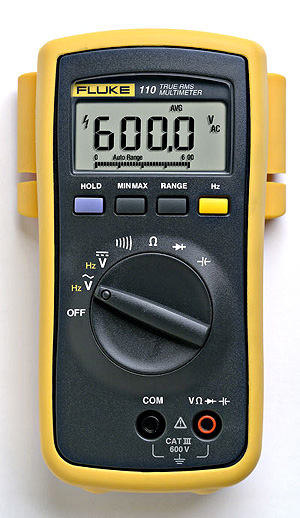 The other day I bought two
Fluke 110 multimeters
for my lab,
then liked them so much I bought one to use at home.
The other day I bought two
Fluke 110 multimeters
for my lab,
then liked them so much I bought one to use at home.
Multimeters have come up in the world since I bought my
trusty Beckman DM25L about twenty years ago.
The Beckman has a big dial with about 50 settings;
it doesn't auto-range.
For years, I distrusted auto-ranging meters because
they seemed to spend all their time vacillating between ranges.
Not the Fluke. It settles on the right range almost
instantly. That may be partly because it starts with
a range that is usually reasonable (e.g., 6 volts)
rather than starting with its lowest range.
Notice that the Fluke 110 doesn't measure current (amps or
milliamps). I chose it deliberately for that reason.
If it measured amps, it would also have one or two more
sockets, and then the students would plug the cables in the
wrong place. Not only that, but ammeters have internal
fuses which, in a student lab, are almost always blown
from trying to use an ammeter as a voltmeter.
The Fluke counts up to 6599, not 1999, so about half the
time, we get an extra digit of resolution.
Checking a PC power supply, we can read 5.013 volts
instead of just 5.01.
The AC ranges are RMS-responding. That's a good thing.
But what I really like is the frequency measurement function.
One of my long-term hobbies is building
controllers
for AC telescope-drive motors.
Being able to connect the meter and read 60.05 Hz is a great help.
My one quibble with the Fluke is that it reads capacitance
in nanofarads. For years, it has been traditional not
to use milli- or nano- with farads (only micro- and pico-).
The reason is that capacitor values span a trillion-to-one range,
and to avoid changing unit prefixes too much, we use only half
of the full set.
I guess I'm going to have to join the newer generation and
use nanofarads. The ubiquitous 0.1-μF capacitors are
now going to be known as 100 nF.
The Fluke doesn't completely replace the old Beckman, which also
reads amps, milliamps, and transistor hFE.
Today I'm going to fix up the old one (which has developed some quirks)
and calibrate it.
If unsuccessful, I may have to get a new one.
The Beckman DM25L lived on for a while in the Wavetek product line,
but it's hard to say what its nearest present-day equivalent is.
Probably the
B&K 2704B.
|
By popular demand I have put a circuit diagram of the DM25L
on line. Click here.
|
Permanent link to this entry

|
 |
2006
May
6
|
No, the comet is NOT going to hit us
A self-proclaimed "psychic" has been e-mailing everybody in the world
saying a fragment of Comet Schwassmann-Wachmann is going to hit Earth on May 25.
He uses the name of NASA in his rather confusing press release.
Well... He's wrong.
The comet is staying well away from Earth.
Here's what NASA actually says.
The comet will stay more than 20 times farther away than the Moon.
Bear in mind that it doesn't move under its own power, so its movements are easy
to predict.
Also, although it is breaking up into fragments, it's not exploding – the
fragments are staying close together, scattered along the same orbit.
None of them has moved violently in some other direction.
If you don't trust NASA, maybe you'll trust me.
I've been observing the comet myself,
and it's definitely not approaching us.
Permanent link to this entry

|
 |
2006
May
5
|
My debut as an artist
Last night, I needed the following diagram (a picture of some transistors
with their pin connections labeled) and couldn't find anything suitable in
a book. Anyhow, I needed a diagram that wasn't taken from any copyrighted
source.
So I laid the transistors down on the table, photographed them,
imported the image into Corel Draw, and drew over it, then
deleted the photographic image. As you can see, it was a great success.
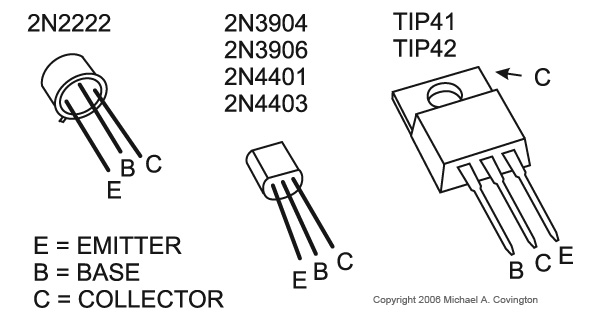
This is a good way to create realistic line drawings even if you're a better
artist than I am.
The idea is to combine the precision of the drafting tools (in my case Corel Draw,
in an earlier era rulers and triangles) with the accuracy of the photograph.
Such techniques, using film photography, were promoted
in
Thinking with a Pencil
many years ago.
Permanent link to this entry

|
 |
2006
May
4
|
What's a DEPAR BUEPDRAVE PRG USB device?
When I plugged my Lexar JumpDrive Pro into my office computer this afternoon,
the computer announced the device as a DEPAR BUEPDRAVE PRG USB Device and
then found it unreadable; it treated it as an unformatted disk.
After several tries, I eventually got the JumpDrive to work properly.
I copied all the files off of it, reformatted it (as FAT16; reformatting
it as FAT32 the previous night may have brought on the problem); and
copied the files back.
Have you cracked the code yet?
DEPAR BUEPDRAVE PRG is what you get if you take
LEXAR JUMPDRIVE PRO in ASCII code and
change bit 3 of each letter (the 4th-from-lowest bit) so that it is always 0.
This changes some of the letters but leaves others unchanged.
Should I be worried? I don't know.
It sounds like a rather deep communication problem between the
JumpDrive memory and its USB port, not a disk formatting problem.
This is a battle-weary JumpDrive but I don't know if I still trust it.
Permanent link to this entry

|
 |
2006
May
3
|
What goes on inside an illuminated rocker switch
One of today's main accomplishments – at work, no less –
was figuring out what goes on inside a
Carlingswitch VJD1 illuminated
rocker switch.
Click on the link to see.
It isn't simple; there are two light bulbs, one of which you never see!
(Unless the switch has a different cover on it than ours did.)
With various kinds of labeling on the cover, this is a common switch in
automotive, aircraft, and boat electrical systems.
Manufacturer's data
here,
not always accessible; I had to make some tests of my own
to actually figure everything out.
Permanent link to this entry
Calendrical checkpoint
Don't forget that tonight
at 3:02:01 A.M. UT (11:02:01 p.m. EDT), the
date and time will be
06/05/04 03:02:01
at least if you write the date and time with the largest units first, as I do
in scientific work.
Permanent link to this entry

|
 |
2006
May
2
|
Practical Artificial Intelligence Workshop
No news today; I'm attending
this conference.
Permanent link to this entry

|
 |
2006
May
1
|
Cosmic rays
Last month I got a bumper crop of astronomical photographs, the best of which are
going to appear here.
But we're still in the end-of-semester crunch, so it's going to take a while.
Here are a few.
First, here's a single frame from a video recording of Saturn.
Normally, I record about 3000 frames and use Registax to select and
align the best.
On this occasion – April 13 – the air wasn't very steady
and my video didn't yield much.
But one frame of it did have these bright spots:
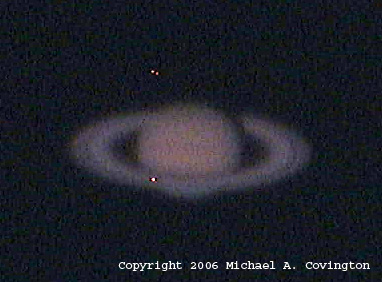
That's what happens when cosmic rays hit the CCD sensor.
Since these three all arrived during the same 1/25-second exposure,
and there were no others all evening, we're probably looking
at three particles generated by the impact of a single higher-energy
particle on an atomic nucleus.
More about this process
here.
Permanent link to this entry
Comet 73P/Schwassmann-Wachmann
The big news among astronomers is of course that Comet 73P/Schwassmann-Wachmann
has broken up. You can see the two brightest fragments in this picture, taken April 23:
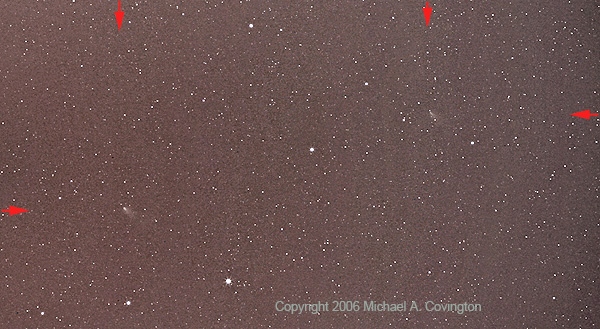
The background is the constellation Corona Borealis; the picture was taken
with a 105-mm f/2.8 lens on my Digital Rebel.
Switching to a 300-mm lens, I got this closeup of the brightest fragment:

The stars look like streaks because two exposures were superimposed, lined up on
the comet, which was moving relative to the stars.
Permanent link to this entry

|
 |
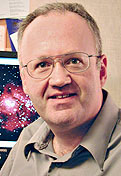

![]()



 What are those things on Inuyasha's face in the picture?
Apparently, they are a Japanese representation of veins throbbing on an
anguished person's forehead.
They remind us that many of the things we see in drawings – arrows,
starbursts, etc. – are not pictures at all; they're
arbitrary symbols that we've gotten used to.
What are those things on Inuyasha's face in the picture?
Apparently, they are a Japanese representation of veins throbbing on an
anguished person's forehead.
They remind us that many of the things we see in drawings – arrows,
starbursts, etc. – are not pictures at all; they're
arbitrary symbols that we've gotten used to.








 The Oxford English Dictionary on CD-ROM is a very handy piece of software; you can
copy all the data files to your PC and run it without the discs.
The Oxford English Dictionary on CD-ROM is a very handy piece of software; you can
copy all the data files to your PC and run it without the discs.




 I use Outlook Express to check e-mail from the same POP3 server
on three different PCs.
I use Outlook Express to check e-mail from the same POP3 server
on three different PCs.




